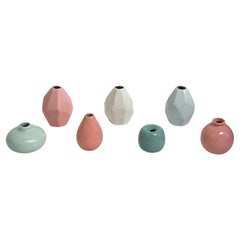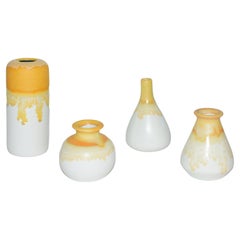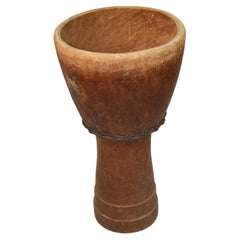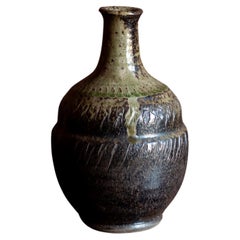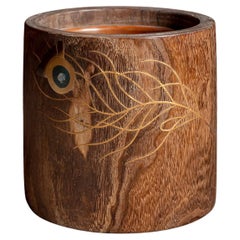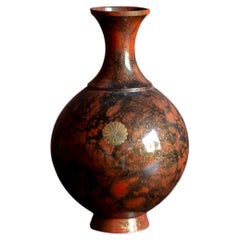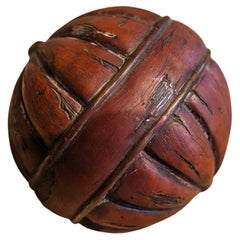Japanese Wabi Sabi
to
122
1,511
400
2,268
1,359
809
699
678
576
370
363
233
163
119
70
52
49
46
40
37
32
31
28
26
26
22
18
17
15
13
12
11
7
7
7
6
5
4
3
2
2
2
1
1
670
102
32
15
14
Sort By
Seven Japanese Wabi Sabi Mini Ceramic Vases Pastels
Located in Somis, CA
has 3 diamond-facet pieces (back row) that are larger and highly artistic. Embracing the Japanese wabi
Category
2010s Japanese Vases
Materials
Porcelain
$124 Sale Price / set
20% Off
H 3.5 in W 3 in D 3 in
Japanese Wabi Sabi Mini Ceramic Vases Golden Leaves Set of Four
Located in Somis, CA
essence of fall leaves and symbolizing harvest and abundance. Embracing the Japanese wabi-sabi philosophy
Category
2010s Japanese Vases
Materials
Porcelain
Japanese Wabi Sabi Drum Planter
Located in Douglas Manor, NY
Japanese drum planter with latter added removable brass tray
Has metal and rope banding on middle.
Category
Vintage 1930s Planters and Jardinieres
Materials
Hardwood
Japanese Pottery Vessel, Japan, Wabi Sabi, Mid-20th Century
Located in Edogawa-ku Tokyo, JP
Japanese pottery vase, mid-20th century, with a strong sculptural presence and wabi-sabi character
Category
Mid-20th Century Japanese Ceramics
Materials
Ceramic
Japanese Wooden Cabinet, Early 20th Century, Japan, Wabi Sabi
Located in Tokyo, Tokyo
wear reflect the passage of time and enhance the cabinet’s wabi-sabi appeal. A perfect addition to an
Category
Early 20th Century Japanese Cabinets
Materials
Wood
Antique Japanese Wooden Hibachi, Japan, Wabi Sabi, 20th Century
Located in Edogawa-ku Tokyo, JP
A beautiful antique Japanese hibachi crafted from richly grained wood, featuring an elegant inlaid
Category
Early 20th Century Japanese Antiquities
Materials
Wood
Japanese Decorative Vessel, Japan, Wabi Sabi, Early 20th Century
Located in Edogawa-ku Tokyo, JP
right, or incorporated into a modern interior as an accent with historical depth and wabi-sabi allure.
Category
Early 20th Century Japanese Vases
Materials
Metal
Japanese Sphere Toy, Japan, Wabi Sabi, 20th Century / Japanese object
Located in Edogawa-ku Tokyo, JP
wabi-sabi interiors.
Category
Early 20th Century Japanese Antiquities
Materials
Wood
Japanese Wabi-Sabi Meiji Period Tansu Chest of Drawers
Located in London, GB
unfortunately without its key. Japanese, c. 1870.
Category
Antique 19th Century Japanese Meiji Commodes and Chests of Drawers
Materials
Iron
Antique Japanese Hibachi with Tools, Japan, Wabi Sabi, 20th Century
Located in Edogawa-ku Tokyo, JP
wear and age, revealing its history and enhancing its wabi-sabi character. The interior, designed to
Category
20th Century Japanese Antiquities
Materials
Wood
$1,100
H 9.45 in W 11.82 in D 11.82 in
Japanese Wabi-Sabi Small Vase, Meiji Period, 1750-1850
Located in Katori-Shi, 12
This is an old Japanese pottery.
It is from the Meiji period (1860s-1900s).
It was used as a fire
Category
Early 20th Century Meiji Antiquities
Materials
Pottery
Japanese Wabi-Sabi Yakusugi Burl Sculpture / Natural Abstract Form Object
By Axel Vervoordt
Located in Chōsei District Nagara, JP
to Japan.
Yakusugi refers to ancient Japanese cedar trees that grow on Yakushima Island in Kagoshima
Category
Mid-20th Century Japanese Taisho Sculptures and Carvings
Materials
Cedar
$1,500
H 18.9 in W 10.24 in D 10.24 in
Vintage Awaji Pottery Drip Vase Japanese Wabi Sabi Zen Ikebana
By Awaji Pottery
Located in Wilton, CT
Vintage Awaji pottery tortured and manipulated vase with two little ears at the shoulder and great suspended drips on an off white crackle glaze ground, circa 1930. 7 1/2" high, 8" d...
Category
Vintage 1930s Japanese Showa Vases
Materials
Pottery
Japanese Wabi Sabi Antique Wooden Low Table/1800-1920/Sofa Table
Located in Sammu-shi, Chiba
aesthetics of “wabi-sabi” and “yugen”. The tip is fastened with iron fittings and has a stately appearance as
Category
Antique 19th Century Japanese Meiji Sofa Tables
Materials
Oak, Pine
$1,500
H 8.08 in W 34.65 in D 31.7 in
Japanese Wabi-Sabi Meiji Taisho Street Vendors Stools Side Bedside Tables
Located in London, GB
combination of heavily patinated elm, pine and cedar timbers. Japanese, c. 1870-1920.
W40 x D23 x H35 cm
Category
Antique 19th Century Japanese Meiji Side Tables
Materials
Elm, Cedar, Pine
$1,088 / item
H 28.15 in W 9.06 in D 15.75 in
Japanese Wabi Sabi Oversized Turned Urn from Solid Block of Wood
Located in Douglas Manor, NY
1390 Japanese Oversized turned hardwood urn.
Category
Vintage 1940s Urns
Materials
Hardwood
1950s Japanese Wabi-Sabi Sandy-Tan Tilted Asymmetric Porcelain Bud Vase MCM
By Gertrud and Otto Natzler
Located in Hyattsville, MD
Wonderful asymmetrical footed bud vase reflecting the Wabi-Sabi tenants of intentional acceptance
Category
Antique Early 1900s Japanese Mid-Century Modern Vases
Materials
Porcelain
$388 Sale Price
20% Off
H 4 in Dm 4.5 in
Shigaraki Jar Tsubo Vase Pottery Mingei Japanese Wabi Sabi Metallic Black Zen
By Shigaraki Valley Potters
Located in Wilton, CT
Vintage Japanese Shigaraki jar in shimmering metallic black glaze, circa early/mid 20th century
Category
Mid-20th Century Japanese Edo Urns
Materials
Stoneware
$750
H 16 in W 13 in D 13 in
19th Edo Japanese wabi sabi dougu Kusuri Tansu, Tool medicine chest of drawers
Located in 常陸大宮市, JP
wabi sabi elements altogether.
Smooth opening & closing operation on all drawers.
Of course, it's
Category
Antique 1860s Japanese Edo Commodes and Chests of Drawers
Materials
Wood, Cedar
$2,000
H 30.71 in W 34.45 in D 13.98 in
19th thick lattice door, antique sliding door w/ panel. Japanese wabi sabi shoji
Located in 常陸大宮市, JP
Japanese antique thick lattice sliding door, ara-koshido,
Edo to Meiji period circa 1870s to early
Category
Antique Late 19th Century Japanese Edo Furniture
Materials
Wood
$682 Sale Price
25% Off
H 69.61 in W 33.86 in D 1.26 in
Japanese Antique Coffee Table, Wabi-Sabi, Early 20th Century
Located in Katori-Shi, 12
world of Japanese “Wabi Sabi”.
The materials, techniques, and design are all at the pinnacle of
Category
Early 20th Century Taisho Coffee and Cocktail Tables
Materials
Wood
Japanese Primitive Bench / Wabisabi Long Bench
Located in Sammu-shi, Chiba
It is a solid wooden bench that makes you feel Japanese wabi-sabi.
It's made of driftwood, but
Category
2010s Japanese Primitive Benches
Materials
Wood
$1,200 Sale Price
20% Off
H 17.72 in W 73.23 in D 15.75 in
Japanese Antique Kuruma Nagamochi / Storage Sideboard / 1800-1860s Wabi-sabi
Located in Iwate-gun Shizukuishi-cho, Iwate Prefecture
great sideboard or display stand to highlight the things you display.
It symbolizes the Japanese wabi
Category
Antique 19th Century Japanese Edo Sideboards
Materials
Iron
$5,000
H 39.97 in W 50.6 in D 24.61 in
Japanese Signed Artisan Mingei Shigaraki Ware Pottery Wabi-Sabi Abstract Vase
Located in Studio City, CA
.
This particular work also encompasses the Japanese Wabi-Sabi aesthetic - the appreciation of beauty
Category
20th Century Japanese Showa Ceramics
Materials
Pottery, Stoneware
$295
H 6 in W 5.25 in D 5 in
19th Century Japanese Burl Wood Dai
Located in Chicago, IL
An incredible 19th century Japanese Wabi Sabi burl wood dai with a perfect circular recessed tray
Category
Antique 19th Century Japanese Rustic Decorative Dishes and Vide-Poche
Materials
Burl
Wabi-Sabi Styled Studio Ceramic
Located in Medina, OH
to have been influenced by the Japanese wabi-sabi style pottery featuring simplicity, imperfection
Category
Mid-20th Century Unknown Japonisme Vases
Materials
Ceramic
French Walnut Stools Attributed to Atelier Marolles in a Wabi Sabi Spirit 20thc
By Atelier Marolles
Located in Chicago, IL
the essence of the Japanese Wabi Sabi aesthetic. They can function as stools or side tables.
The
Category
Mid-20th Century French Minimalist Stools
Materials
Walnut
$7,500 / set
H 16.25 in W 22 in D 16 in
Japanese Asian Large Ceramic Stoneware Studio Pottery Wabi-Sabi Bowl Charger
Located in Studio City, CA
undulating rim-flow design.
This particular piece encompasses the Japanese Wabi-Sabi aesthetic (which is
Category
20th Century Japanese Showa Ceramics
Materials
Stoneware
$895
H 3.9 in W 18.4 in D 18.25 in
Japanese Asian Signed Studio Pottery Wabi-Sabi Ceramic Glazed Chawan Tea Bowl
Located in Studio City, CA
with various shifts in colour and texture.
This particular piece encompasses the Japanese Wabi-Sabi
Category
20th Century Japanese Showa Ceramics
Materials
Earthenware
$495
H 2.5 in W 4.5 in D 4.5 in
Japanese Asian Signed Studio Pottery Wabi-Sabi Red & Gold Glazed Yunomi Teacup
Located in Studio City, CA
Yunomi encompasses the Japanese Wabi-Sabi aesthetic (which is so revered and coveted in Japan) - the
Category
20th Century Japanese Showa Ceramics
Materials
Earthenware
$495
H 4 in W 3.5 in D 3.5 in
Japanese Asian Signed Studio Pottery Wabi-Sabi Ceramic Glazed Chawan Tea Bowl
Located in Studio City, CA
personal favorites.
This particular piece encompasses the Japanese Wabi-Sabi aesthetic (which is so
Category
20th Century Japanese Showa Ceramics
Materials
Stoneware
$695
H 3.25 in W 5.25 in D 5.25 in
Japanese Signed Wabi-Sabi Pottery Glazed Chawan Tea Bowl Style of Bernard Leach
Located in Studio City, CA
particular piece also encompasses the Japanese Wabi-Sabi aesthetic (which is so revered and coveted in Japan
Category
20th Century Japanese Folk Art Decorative Bowls
Materials
Earthenware, Pottery
$595
H 3.75 in Dm 5.5 in
Sugimoto Sadamitsu Signed Japanese Shigaraki Pottery Wabi-Sabi Art Vase
Located in Studio City, CA
/pottery mark on the base.
This particular work also encompasses the Japanese Wabi-Sabi aesthetic - the
Category
20th Century Japanese Showa Ceramics
Materials
Stoneware
$995
H 8.75 in W 4.75 in D 4.75 in
Wabi-Sabi Contemporary Man Brooch in Frosted Silver Designed by the Artist
By Polya Medvedeva Jewellery
Located in Berlin, DE
that reflect the Japanese wabi-sabi tradition.
The Bamboo collection was designed by Polya Medvedeva
Category
2010s German Contemporary Brooches
Materials
Silver, Sterling Silver
Japanese Antique Ancient Sueki Sue Ware Wabi-Sabi Pottery Vase Pot Vessel
Located in Studio City, CA
bronze pieces imported from China at the time.
This particular piece also encompasses the Japanese Wabi
Category
Antique 15th Century and Earlier Japanese Ceramics
Materials
Pottery, Stoneware
Japanese Asian Signed Studio Pottery Wabi-Sabi Ceramic Glazed Chawan Tea Cup
Located in Studio City, CA
.
This particular piece also encompasses the Japanese Wabi-Sabi aesthetic (which is so revered and
Category
20th Century Japanese Showa Ceramics
Materials
Earthenware, Pottery
$395
H 4 in W 3 in D 3.25 in
Japanese Asian Signed Studio Pottery Wabi-Sabi Ceramic Glazed Chawan Tea Bowl
Located in Studio City, CA
.
This particular piece also encompasses the Japanese Wabi-Sabi aesthetic (which is so revered and
Category
20th Century Japanese Showa Ceramics
Materials
Earthenware, Pottery
$425
H 2.65 in W 4.35 in D 4.75 in
Japanese Asian Signed Studio Pottery Wabi-Sabi Ceramic Glazed Chawan Tea Bowl
Located in Studio City, CA
.
This particular piece also encompasses the Japanese Wabi-Sabi aesthetic (which is so revered and
Category
20th Century Japanese Showa Ceramics
Materials
Earthenware, Pottery
$450
H 3 in W 4.25 in D 4.5 in
Japanese Old Aluminum Glove Mold 1940s-1960s / Object Wabi Sabi
Located in Chōsei District Nagara, JP
viewer's imagination.
The spirit of the Japanese “wabi-sabi” spirit lives on in these hand molds
Category
Mid-20th Century Japanese Showa Metalwork
Materials
Aluminum
Japanese Antique Edo Wabi-Sabi Shigaraki Tamba Tanba Art Pottery Jar Tsubo Vase
Located in Studio City, CA
organic ash glaze and wonderful texture. The work encompasses the Japanese Wabi-Sabi aesthetic (which is
Category
Antique 18th Century Japanese Edo Ceramics
Materials
Pottery, Stoneware
Japanese Antique Ancient Sueki Sue Ware Wabi-Sabi Art Pottery Vase Storage Jar
Located in Studio City, CA
bronze pieces imported from China at the time.
This particular piece also encompasses the Japanese Wabi
Category
Antique 15th Century and Earlier Japanese Ceramics
Materials
Pottery, Stoneware
$1,995
H 10 in Dm 8.5 in
Japanese Asian Antique Shino Yaki Ware Studio Pottery Wabi-Sabi Chawan Tea Bowl
Located in Studio City, CA
Japanese Wabi-Sabi aesthetic (which is so revered and coveted in Japan) - the appreciation of beauty that
Category
Mid-20th Century Japanese Showa Ceramics
Materials
Pottery, Stoneware
$495
H 3.75 in Dm 5.5 in
Wabi-Sabi Bamboo Brooch N2 in Frosted Silver by the Artist
By Polya Medvedeva Jewellery
Located in Berlin, DE
magazines and its texture and lines reflect the Japanese wabi-sabi tradition. The design of the Bamboo
Category
21st Century and Contemporary German Artist Brooches
Materials
Silver, Sterling Silver
Japanese Antique Ancient Sueki Sue Ware Wabi-Sabi Pottery Vase Vessel Urn
Located in Studio City, CA
encompasses the Japanese Wabi-Sabi aesthetic - the appreciation of beauty that is imperfect, impermanent, and
Category
Antique 15th Century and Earlier Japanese Folk Art Ceramics
Materials
Pottery, Stoneware
$895
H 5 in W 3.75 in D 3.75 in
Japanese Antique Primitive Armchair 1860s-1920s / Side Chair Wabi Sabi
Located in Chōsei District Nagara, JP
“wabi-sabi,” and it evokes beauty in imperfection rather than perfection.
It is recommended as an art
Category
Early 20th Century Japanese Primitive Armchairs
Materials
Wood
$1,000
H 17.33 in W 20.67 in D 21.26 in
Robert Lee Morris Wabi Sabi Collection Copper Bagel Cuff 1981
By Robert Lee Morris
Located in New York, NY
Japan, Wabi Sabi signifies objects that are worn, aged and filled with soul. The beauty is not in the
Category
Vintage 1980s American Modern Cuff Bracelets
Materials
Copper
$750
H 1.5 in W 3.2 in D 2.65 in Dm 3.2 in L 1.5 in
CHANEL 2022 New CC Turnlock Wabi Sabi Suit 36 FR
By Chanel
Located in Dubai, AE
evokes the Japanese wabi-sabi spirit — beauty drawn from imperfection, from the poetry of time-etched
Category
2010s Loungewear
Japanese Antique Momoyama Edo Bizen Ware Pottery Wabi-Sabi Art Tsubo Jar Vase
Located in Studio City, CA
", encompasses the Japanese Wabi-Sabi aesthetic - the appreciation of beauty that is imperfect, impermanent, and
Category
Antique 16th Century Japanese Edo Ceramics
Materials
Stoneware
$1,495
H 10.25 in W 8.5 in D 8.5 in
Japanese Asian Antique Shino Yaki Ware Studio Pottery Wabi-Sabi Chawan Tea Bowl
Located in Studio City, CA
mark.
This particular piece also encompasses the Japanese Wabi-Sabi aesthetic (which is so revered
Category
Mid-20th Century Japanese Showa Ceramics
Materials
Pottery, Stoneware
$595
H 3.85 in Dm 5.25 in
Japanese Asian Antique Shino Yaki Ware Studio Pottery Wabi-Sabi Chawan Tea Bowl
Located in Studio City, CA
with the maker's mark.
This particular piece also encompasses the Japanese Wabi-Sabi aesthetic
Category
Mid-20th Century Japanese Showa Ceramics
Materials
Pottery, Stoneware
$595
H 3.75 in Dm 5.5 in
Japanese Modern LAAB Wake Vase Raku Ceramic Green White Black Metal
By LAAB Milano
Located in monza, Monza and Brianza
Wake Vase
A vase representing the concept of japanese Wabi-sabi, revealed the moment the piece
Category
21st Century and Contemporary Italian Modern Ceramics
Materials
Ceramic
Japanese Asian Bizen Yaki Ware Wabi-Sabi Studio Pottery Chawan Tea Bowl
Located in Studio City, CA
particular piece encompasses the Japanese Wabi-Sabi aesthetic (which is so revered and coveted in Japan
Category
20th Century Japanese Showa Ceramics
Materials
Pottery, Stoneware
$395
H 3.25 in W 5.25 in D 5 in
Japanese Antique Edo Meiji Wabi-Sabi Tanba Tamba Art Pottery Vase Jar Pot
Located in Studio City, CA
sense of the warmth of the earth and of the people.
The work encompasses the Japanese Wabi-Sabi
Category
Antique Late 19th Century Japanese Meiji Ceramics
Materials
Earthenware, Pottery
Japanese Antique Natural Wood Large Candle Stick 1860s-1900s / Wabi Sabi
Located in Chōsei District Nagara, JP
and strength embody the spirit of Japanese “wabi-sabi,” and it provides deep marginality and serenity
Category
Early 20th Century Japanese Meiji Candlesticks
Materials
Iron
$900
H 37.8 in W 9.45 in D 7.88 in
Five Japanese Jian Ceramic Wine Bottles Vases Red Gradient
Located in Somis, CA
Japanese wabi-sabi philosophy, they celebrate the beauty of imperfection and the natural processes of
Category
2010s Japanese Vases
Materials
Porcelain
$124 Sale Price / set
20% Off
H 5 in W 3.5 in D 3.5 in
Japanese Wall Light / Reproduction of Japanese Antique Lighting Wabi Sabi
By Japanese Studio
Located in Chōsei District Nagara, JP
This is our Japanese wall light.
It is a faithful reproduction of an antique light that was popular
Category
2010s Japanese Meiji Wall Lights and Sconces
Materials
Brass
$650 / item
H 7.09 in W 5.12 in D 9.85 in
Charlotte Perriand Cansado Bench in Mahogany Wood Bench
By Charlotte Perriand
Located in Chicago, IL
character of this piece. Here we see the principle of the Japanese wabi-sabi, which refers to embracing
Category
Vintage 1950s French Mid-Century Modern Benches
Materials
Steel
Henry Dunay 18k Yellow Gold Rope-Twist Knot Ring
By Henry Dunay
Located in Palm Beach, FL
by the Japanese wabi-sabi aesthetic, which embraces asymmetry, simplicity, and the integrity of
Category
Early 2000s American Dome Rings
Materials
18k Gold, Yellow Gold
- 1
- ...
Get Updated with New Arrivals
Save "Japanese Wabi Sabi", and we’ll notify you when there are new listings in this category.
Japanese Wabi Sabi For Sale on 1stDibs
With a vast inventory of beautiful furniture at 1stDibs, we’ve got just the Japanese wabi sabi you’re looking for. A Japanese wabi sabi — often made from wood, ceramic and pottery — can elevate any home. If you’re shopping for a Japanese wabi sabi, we have 36 options in-stock, while there are 1 modern editions to choose from as well. There are many kinds of the Japanese wabi sabi you’re looking for, from those produced as long ago as the 18th Century to those made as recently as the 21st Century. A Japanese wabi sabi, designed in the Arts and Crafts or Mid-Century Modern style, is generally a popular piece of furniture. Many designers have produced at least one well-made Japanese wabi sabi over the years, but those crafted by Skoby Joe are often thought to be among the most beautiful.
How Much is a Japanese Wabi Sabi?
Prices for a Japanese wabi sabi can differ depending upon size, time period and other attributes — at 1stDibs, they begin at $68 and can go as high as $6,800, while the average can fetch as much as $1,200.
Questions About Japanese Wabi Sabi
- 1stDibs ExpertMay 5, 2023The primary principle of Wabi-Sabi is to appreciate the imperfections found in nature. As a result, Wabi-Sabi emphasizes asymmetry, roughness, simplicity and the use of natural materials and finishes. On 1stDibs, shop a variety of pieces based on Wabi-Sabi principles.
- What is wabi-sabi pottery?1 Answer1stDibs ExpertApril 5, 2022Wabi-sabi pottery refers to earthenware vessels that embody the principles of a Japanese philosophy called wabi-sabi. Proponents of the idea believe that household objects should emphasize function over form, so that they satisfy needs but do not cause people to attach too much meaning to worldly possessions. There is also a focus on finding the beauty in imperfection and simplicity. On 1stDibs, find a collection of wabi-sabi pottery.
- What is wabi-sabi furniture?1 Answer1stDibs ExpertApril 5, 2022Wabi-sabi furniture refers to tables, seats and other furnishings that reflect a specific Japanese design philosophy. It involves creating minimalist furniture that has a focus on appreciating the imperfections found in nature. On 1stDibs, find a collection of wabi-sabi furniture.
- What is an example of wabi-sabi?2 Answers1stDibs ExpertApril 5, 2022Wabi-sabi is the practice of finding the beauty in imperfections. Examples include flowers growing through cracks in the ground, or a broken ceramic bowl made whole again with its imperfections showing through. You’ll find a variety of wabi-sabi pieces from some of the world’s top sellers on 1stDibs.1stDibs ExpertApril 5, 2022One important aspect of wabi-sabi is the beauty in imperfect things, so a good example of wabi-sabi would be asymmetrical or even crude vessels and furniture. On 1stDibs, you’ll find a collection of wabi-sabi furniture and other objects from some of the world’s top sellers.
- Is Wabi-sabi a design style?1 Answer1stDibs ExpertMay 5, 2023Wabi-sabi is technically not a design style, but it has influenced design. The term Wabi-sabi refers to a philosophy that emphasizes accepting imperfection and celebrating the impermanent beauty of nature. This concept has inspired many interior design trends, such as using organic and sustainable materials, selecting upcycled and repurposed pieces and integrating furniture and decorative objects that are unfinished, unpolished and unglazed. Shop a collection of pieces inspired by Wabi-sabi on 1stDibs.
More Ways To Browse
Tamba Vase
Japanese Wooden Hibachi
Sue Pottery
Antique Craftsman Lathe
Japanese Seto Yaki
Shigaraki Tsubo
Bizen Vase Signed
Hand Carved Wooden Duck Decoys
Antique Japanese Tapestry Wall Hanging
Antique Japanese Bizen Vase
Iga Ware
Old Duck Decoys
Japanese Medicine Chest
Sue Ware
Wood Carved Tiger Japan
Takahashi Pottery
Jian Ware
Antique Shoji
